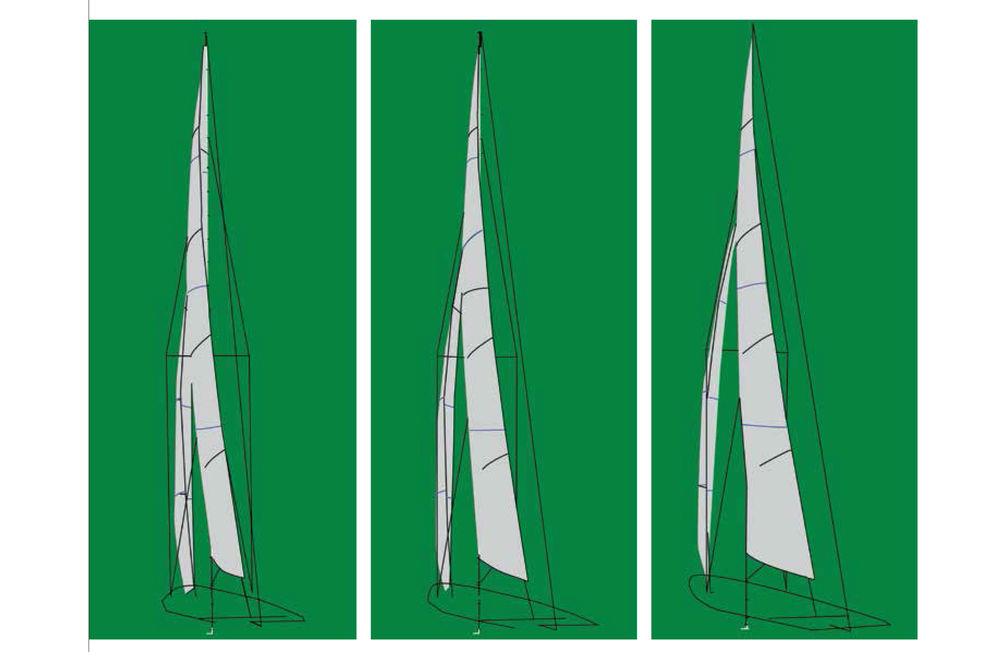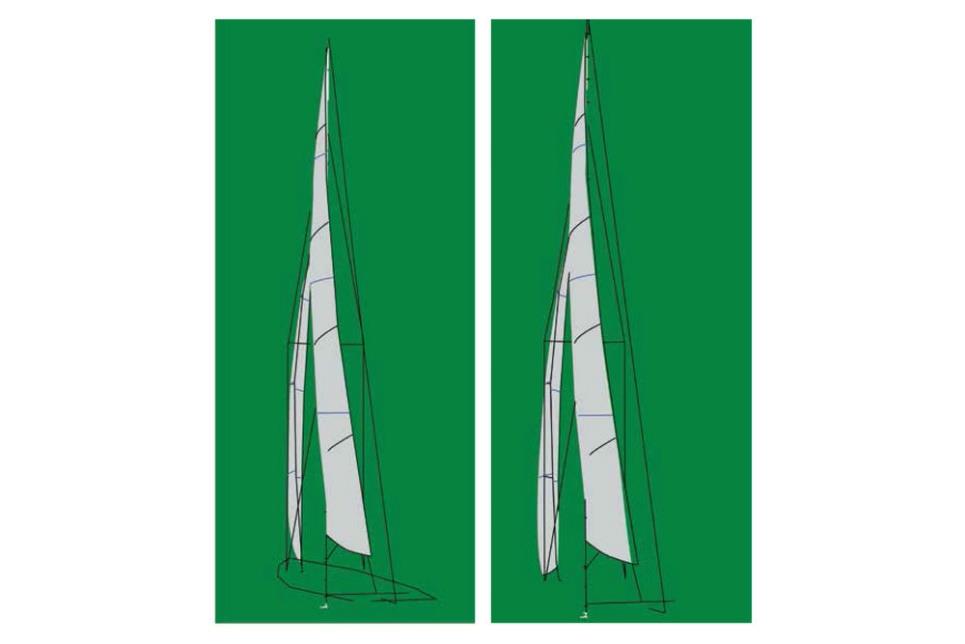Move the lead for better speed
Learning the ins and outs (and fore and aft) of jib leads will help you maximize the performance of your headsail.
The jib lead’s fore and aft movement changes foot depth. A simulation using North Sails’ Flow/Membrane software shows the effect of moving the lead aft, which flattens the bottom of the jib. The simulation at right shows the effect of the lead moving forward, powering up the bottom. In both cases, the change in depth continues up the jib, gradually having less impact until, about halfway up, there’s little noticeable difference.
I had just started crewing on a Tornado catamaran, and it was my job to set and trim the jib. There was a lot of talk about measurements from the bow, aft, and the rail inboard. As a dinghy sailor, the cat was so foreign to me I figured those measurements were a good place to start, but then one of my non-cat friends asked, “Don’t you just want the jib to break evenly?” This simple question pointed to the obvious: Every boat has unique sail shape characteristics, but the fundamental concepts behind how to set the jib leads are the same across all boats.
Although it’s a great starting point, and it would be nice to simply set the leads to “break evenly,” there’s much more we can do with them to maximize the jib’s performance. Adjustments forward or aft change the power of the jib, and the lead’s lateral position (inboard or outboard) affects pointing. The goal here is to develop an understanding of what both lead adjustments do, and to help establish an all-around sweet spot. Once there, we can explore subtle changes to make the jib more versatile. Let’s start with some thoughts about moving a lead fore and aft:
Break even: Moving a lead forward or aft changes the angle at which the sheet pulls down on the clew. Moving the lead forward pulls the clew down and trims the top of the jib. Moving it aft opens the top of the jib. If you trim the jib, and the bottom luff telltales are streaming on both sides and the top, inner telltales are not streaming, you can move the lead forward to trim the top. If the top, outer telltale isn’t streaming, moving the lead aft will correct that. This is the “break even” method: With the top and bottom luff telltales streaming on both sides, heading up a little causes the top and bottom inner luff telltales to “break” at the same time.
Leech tension: Pulling down on the clew by moving the lead forward tightens and hooks in the leech, while moving them aft twists it open.
Foot depth: Moving the lead aft flattens the bottom of the jib. Moving it forward rounds the bottom and powers up the sail. Even though it only affects the bottom-third of the jib, it’s important because the jib is triangular and that bottom third is a significant percentage of the sail.
Before we get into how best to make jib-lead adjustments, we first need to establish a sweet spot. We can’t go wrong with the “break even” method for the fore/aft lead because, top to bottom, the jib is pulling the boat evenly. The inboard/outboard position, which affects your ability to point, isn’t so easy. Often, the boat will have only jib tracks running fore/aft, so adjusting them laterally isn’t an option. If there is a way to move them in and out, however, start with the tuning guide recommendation, or ask a fast competitor. The only method I know of to find this ideal in/out position is to try various settings until you find the right combination of speed and point. If they are too far outboard, the boat will feel great, but you can’t point. If they are too far inboard, the boat may point fine, but you’re slow. In moderate wind and waves, once the jib breaks evenly top to bottom (using the break-even method), experiment with your leads in and out until you get the best combination of speed and point. Then, mark and measure those settings—that’s your sweet spot.

The jib lead’s lateral movement changes how far outboard the entire leech of the jib is without significantly changing the shape. The Flow/Membrane simulation at left shows the lead inboard, and the next two images model them progressively further outboard. The jib “barn door” opens, hinging on the forestay. The leech opens top to bottom, keeping the same shape and twist. While experimenting with the leads inboard and outboard, it’s worth experimenting with sheet tension, respectively, to keep the top leech telltale streaming, yet near the edge of stall, so the top is trimmed correctly. This will affect leech tension and twist, so be careful not to overdo it.
If the water is very flat in moderate breeze, the leads can be pulled aft a setting or two to flatten the bottom of the jib. Trim the sheet tight so the extra flatness at the bottom of the jib will allow you to point higher with little loss of speed. The compromise is that the top of the jib will be slightly under-trimmed, but since you are not looking for power that’s OK. I like the clew inboard a little in these conditions, but I find I don’t need to bring the leads inboard because, by sheeting tighter, the clew of the jib is already being pulled to windward.
If you need power because of waves, moving the lead forward will power up the jib. I like the clew outboard a little in these conditions, but there is no need to move the lead out because you will be easing the jib sheet to keep it powered up, and the clew will fall further outboard anyway. In these conditions, it’s really easy to over-trim the jib because the leads are a little forward to round the foot, and that pulls down on the leech. You don’t want a tight sheet causing a tight leech because the boat is sailing a low, powered-up angle and the slot is already narrowed with mainsheet eased.
In heavy wind and flat water, move the lead aft from the break-even setting. Doing so flattens the bottom while twisting open the top–both are good methods to depower. This is a good time to pull the lead outboard a little, too, if you’re really overpowered. Be careful not to go too far outboard because you will loose the ability to point.
There are usually waves with big wind, however, so you’ll want to moderate how much you flatten the bottom by moving the lead aft. In waves, you’ll be easing your jib sheet, and that will automatically twist open the top and move the clew outboard. It’s worth going to leeward to see how much so, because—depending on the geometry—every boat’s jib eases differently. If, when you ease the sheet, it rounds the bottom too much, perhaps a little aft on the lead will work well. If, however, the top opens dramatically when you ease, moving the lead aft will cause too much twist. In that case, moving the lead outboard might be a good choice because you can trim a little firmer, reducing twist without closing off the lower portion of the slot.
In light wind, the weight of the clew and the sailcloth hang on the jib, having the same effect on the jib as moving the lead forward (pulling down). As the wind gets very light, you will find you will need to move your leads aft to keep the jib breaking evenly. If it is extremely light, hold the clew up by trimming by hand.
Each boat has different geometry, so it is a useful exercise to experiment, noting what each change does. Pay particular attention to the depth of the bottom of the jib and the tightness of the leech. There is one last sanity check: With the leads set with the jib breaking evenly, look at the foot of the jib. If it looks flat or even stretched, try moving the lead forward until it has some shape. If it looks unreasonably round, move the lead back. These are all subtle changes, but they have a surprisingly big impact.
Thanks to Mike Marshall, a sail designer at North Sails One Design. Marshall used Flow/Membrane design analysis software, a part of the North Sails Design Suite. Membrane, as well as the rest of the suite, model rig geometry and mast and sail properties in a specific onset flow to determine the sail shapes. For this analysis, he modeled movements in the leads while keeping all the other variables the same.


